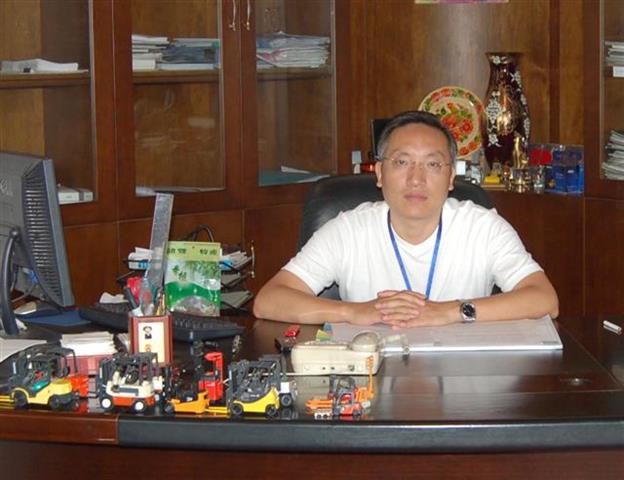 John He: We have both outside and inside demands |
By Paris Lord
John He has been president of China's EP Equipment for more than 20 years.
In that time, he's seen the company grow phenomenally - particularly in the past decade.
"The turnover for the last 10 years has grown 30% each year," he tells
Forkliftaction.com News.
"So our focus for the next five years is also to increase our [annual] turnover by 30%."
Speaking from the firm's base in Hangzhou, capital of eastern China's Zhejiang province, He is tight-lipped about his age, saying only that he is "more than 40".
Having studied forklift technology and computers at university in south western China, He says his role is finding the balance between his employees' and customer demands.
"My thinking is we have both outside and inside demands," he explains.
"Outside demands are customer demands, such as quality, price and technical aspects. The inside demands are my employees. They need development and ... to have a good life. If I can satisfy both sides, EP can succeed."
He is working "step by step" to achieve that balance, and considers getting feedback and suggestions from customers and staff as crucial.
"First, when customers are coming [to our office], I will spend some time with them, to ask some questions and know their demands," He says. "Second, I will always attend trade shows to know what the market demands. "Sometimes, customers send me emails to talk about the future, talk about problems, talk about the market."
EP Equipment's main markets include Japan, United States and the European Union and He notes that the requirements or expectations differ with each destination. "For example, product inspections in the American and European markets are different," he says.
"Second, the American market focuses on strength. They need products to be stronger than others, while (for) the European market, it's maybe about the (appearance) of a product and also its quality. For other markets, it's about price."
About 40% of He's time is spent dealing with customers' demands. The remainder goes to inside management and the technical side of new products.
EP Equipment plans to introduce at least 10 new products to the market by the end of 2009, he says, adding one of the company's future goals is to specialise in electric warehousing equipment and forklifts.
"We will also be doing a 'one-stop shop' for all materials handling equipment."
Among the ways He likes to use his time after work is by swimming. He tries to swim at least three times a week at a nearby hotel, swimming one kilometre per visit. Another pastime is drawing with pencils, designing machinery and other technical parts of the job.
Being in the water or with pencil in hand allows him to think about addressing the company's challenges.
The chief says the company knew 2008 would be a difficult year, particularly because of the slowdown in the USA.
"We prepared some measures to absorb that, firstly by expanding our exports ... all over the world," he says. "Second, we think that even if the economy's not good, if we can give good service, good quality products, we will have space to develop."
For example, South America was a new destination in 2008 for EP Equipment, especially Brazil.
"We've sold about 300 forklifts in Brazil so far this year, and we have the number one share of the market now," He says. That compares to "some" units it exported there in 2007.
China and its forklift industry have experienced immense changes in the past 20 years, bringing with them challenges for people such as He.
Noting that the demands of each export market are great, He says the company is aware the job will become tougher as it expands.
"Inside China, labour costs, material costs, the Chinese yuan and also shipment costs have increased," He notes.
Chinese forklifts have developed rapidly over half a decade, but He tips the competition will encounter slowing demand over the next few years. In response, the company intends to beef up the technical and service sides of the business.